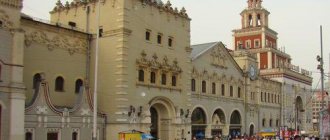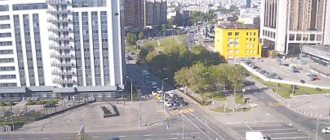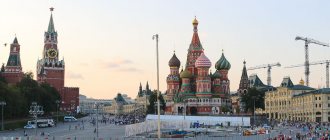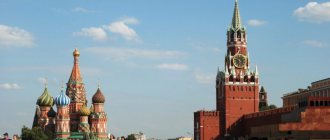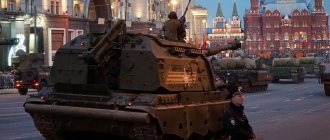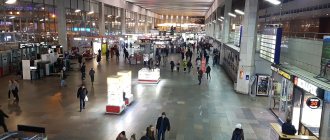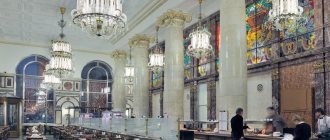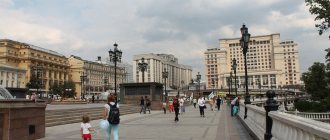Red Square is considered the capital's main attraction. It attracts the attention of more than 95% of tourists and is located in the very “heart” of Moscow. Since the central attraction borders on two metro interchange hubs, you can get to Red Square by metro from almost any part of the metropolis.
The first interchange point is 3 stations - “Okhotny Ryad”, “Revolution Square” and “Teatralnaya”. This is the intersection point that unites the green, red and blue lines of the Moscow metro:
- Having reached one of the mentioned stations, leave the underground public transport and look for a sign that says “Manezhnaya Square”.
- Go up the street and you will see the museum (red brick building).
- Go around it and you will find yourself in the right place.
The 2nd interchange hub has 4 stations - “Arbatskaya”, “Borovitskaya”, “Alexandrovsky Sad” and “Library named after. Lenin":
- Having reached one of the mentioned stations, go up the street and follow the sign “Alexandrovsky Garden”.
- Go up the street and you will see the Kremlin wall.
- Move to the right and after about 7 minutes of walking you will reach Red Square.
You can visit the square 24 hours a day. It's absolutely free.
Important! The attraction may be closed to visitors only on special holidays. Including on Victory Day (May 9) and a few days before the parade, since the rehearsal takes place here.
There is video surveillance installed along the entire perimeter of Red Square, which means that you won’t be able to organize a picnic or a noisy party here.
You can get from the capital's airports to Red Square by train. You need to take the Aeroexpress and proceed to any railway station. Next, the most convenient way is to use the metro.
From Yaroslavsky railway station
You can get to Red Square from Yaroslavsky station on the Sokolnicheskaya metro line. On Komsomolskaya Square there is a station of the same name, which unites three stations (Kazansky, Leningradsky, Yaroslavsky):
- Take underground transport from the Komsomolskaya metro station and get off at the Okhotny Ryad station.
- Follow the sign towards Manezhnaya Square.
- Proceed to the exit.
- When you see the museum building (a red brick building), walk around it from either side.
- Now you are in place.
Red Square: nearest metro, how to get there
As you might guess, Red Square is located in the very center of the capital. Near the square there are several metro stations, more precisely, several entire interchange hubs - stations of different lines that are connected to each other by passages and have several exits to the surface. You can arrive at any station that is closest to your hotel or train station.
The first interchange connects 3 stations:
- Okhotny Ryad . Sokolnicheskaya (red) metro line. On this line there are Kazansky, Leningradsky and Yaroslavsky stations (Komsomolskaya metro station).
- Teatralnaya . Zamoskvoretskaya (green) metro line. On this line there are also Belorussky Station (Belorusskaya metro station), Paveletsky Station (Paveletskaya metro station), Northern River Station (Rechnoy Vokzal metro station).
- Revolution square . Arbatsko-Pokrovskaya (dark blue) metro line. Kyiv Station is also located on this line (Kyiv metro station)
After arriving at one of the stations, look for signs like “Exit to the city. Manezhnaya Square". When you find yourself on the surface, you will certainly see a huge red building with two tall pointed towers. This is the Historical Museum. Behind the museum is Red Square. It can be bypassed from any side. If you go around the museum on the right, you will find yourself closer to the Kremlin wall and Lenin's mausoleum. If you go around the museum on the left side, your path will go through the Resurrection Gate, in front of which there is a symbolic monument, the Zero Kilometer of Russian Highways. Here you can toss a coin and make a wish.
The second interchange hub unites 4 stations:
- Library named after Lenin . Sokolnicheskaya (red) metro line. On this line there are Kazansky, Leningradsky and Yaroslavsky stations (Komsomolskaya metro station).
- Arbatskaya . Arbatsko-Pokrovskaya (dark blue) metro line. On this line there is also Kyiv Station (Kyiv metro station).
- Borovitskaya . Serpukhovsko-Timiryazevskaya line (gray) metro line.
- Alexander Garden . Filevskaya (blue) metro line. On this line there is also Kyiv Station (Kyiv metro station).
After arriving at one of these stations, look for a sign like “Exit to the city. Alexander Garden". If there are no such signs, then you can simply ask any passer-by how to get to the Alexander Garden, or the Kremlin, or Red Square.
When you reach the surface, you will find yourself in the Alexander Garden, you will see the Kremlin wall, Kutafya and the Trinity towers of the Kremlin, connected by a bridge. Tourists enter the Moscow Kremlin through the Kutafya Tower. But since our goal is different, we need to turn left and walk through the Alexander Garden along the Kremlin wall for about 400 meters. Along the way you will see the Grotto, the eternal flame and the upper part of the shopping mall. Soon you will see that the Kremlin wall turns and a huge space opens up in front of you - this is Red Square.
Surprisingly, the Red Square metro station does not exist. Therefore, those who have never been to our capital often ask “How to get to Red Square.”
Useful tips
Red Square is open to the public almost always, with the exception of some holidays, for example, May 9 and a few days before this date, when parade rehearsals are held.
Visiting the square is free
. Visiting the Lenin Mausoleum is also free, but it is open only a few days a week for a few hours. Before visiting the mausoleum, you must go through a metal detector, and large bags are forced to be checked into a paid storage room. Therefore, it is recommended to take this walk lightly. Read more about the Mausoleum of V.I. Lenin
In connection with the latest events in Moscow, on Red Square and around it, there is simply an unimaginable number of police officers, whose main job is checking documents. Although Russian citizens are not required to carry identification documents with them, it is still strongly recommended to take with you your passport and tickets with which you arrived in the capital in order to avoid misunderstandings.
The entire territory of Red Square is monitored by video cameras, so you won’t be able to have a picnic with guitars, beer, or even organize your own flash mob here.
From Kazansky railway station
You can also get from Kazansky Station to Red Square via the Sokolnicheskaya metro line (red line of the metro):
- At Three Stations Square, go down to the Komsomolskaya metro station.
- Get on the train and get off at Okhotny Ryad station.
- Find the sign indicating the path to Manezhnaya Square.
- Go outside.
- Walk around the red brick building of the museum from any side and you will find yourself there.
Important! Don't mix up the branches. The brown line is a ring line.
From Kievsky railway station
To get from Kievsky Station to Red Square, you just need to use underground public transport. The journey will take about 20 minutes:
- Take the metro at Kyiv station (dark blue line).
- Get off at the station "Pl. Revolutions."
- Take the escalator up to the exit towards the museum.
- Walk around the red brick building and you will find yourself in the right place.
Important! Knowing the name of your destination, it’s hard to get lost in the metro. Read signs and symbols carefully.
From Belorussky railway station
Get to Belorussky Station using the Aeroexpress from Sheremetyevo Airport:
- Go down to Belorusskaya station.
- Take the Zamoskvoretskaya metro line (green) and proceed to Teatralnaya station.
- At this station, go out onto the street following the sign “Manezhnaya Square”.
- Rising to the surface, you will come across the building of the Historical Museum. Walk around the museum and you will find yourself where you need to be.
Important! Proceeding to the right of the museum building, you can get to the Mausoleum and the Kremlin wall. On the left side are the Resurrection Gate and the Zero Kilometer monument.
Show Me Moscow: Tverskaya Square
I thought for a long time about where to start my stories and decided that it would be very symbolic to make the starting point Tverskaya Square, where the monument to the founder of our city, Yuri Vladimirovich Dolgoruky, is now located.
The house on Tverskaya, which now houses the capital's mayor's office, was built by the Moscow Count-Governor Chernyshev back in 1782 according to the design of the famous architect Kazakov, and from then on this house was permanently the governor-general's house until the revolution. The facade overlooked Tverskaya Square, later renamed Skobelevskaya, and after the revolution, Sovetskaya. One day the mansion was actually sold, without any consent of the governor himself. In the late 70s of the 19th century, a gang of “Chervonnye Valts” operated in Moscow - talented swindlers, led by a certain Pavel Speyer, who, under the guise of a merchant, made acquaintance with the then governor-general, Prince Dolgorukov. Dolgorukov liked the courteous “merchant”, and Speyer began to attend the highest receptions. One day, a new acquaintance asked Dolgorukov for permission to show the brilliant governor’s house to his British friend, the prince agreed, and the next day, accompanied by the official on duty, the Englishman inspected the rooms on Tverskaya. A couple of days later, the former guest returned with suitcases and a bill of sale*. The poor Briton was sure that the owner of the mansion was Pavel Speyer himself, and the deed of purchase for the house, for which he paid 100,000 rubles, was a real document. For information, say that 100 rubles of those times are comparable today to approximately 800,000 rubles! Just imagine what the amount was and what level of fraud it was. Also under the square there is an abandoned metro station “Sovetskaya”. Was in the original project of the second stage of the Moscow metro. It was supposed to be located on the Zamoskvoretskaya line between the Teatralnaya and Mayakovskaya stations. But already in 1934 this station was excluded from the Gorky radius project**. Later, in the place where the station was planned, a bunker for the headquarters of the Moscow Civil Defense was built. From the Tverskaya-Teatralnaya stretch to the so-called “Sovetskaya” you can get through two junctions on the right along the 2nd path towards Teatralnaya before the right curve.
*Deed of sale is an outdated form of using a purchase and sale agreement;
**In Soviet times, Tverskaya Street was called Gorkovskaya, and now the Zamoskvoretskaya metro line was called “Gorkovsko-Zamoskvoretskaya” Tags Gorkovsky radius project Tverskaya Square
From Paveletsky station
You can get to the Paveletsky railway station by Aeroexpress from Domodedovo Airport. To get to Red Square, you next need to use the metro:
- From the station, take the Zamoskvoretskaya line to Teatralnaya station.
- Exit the metro using the sign towards Manezhnaya Square.
- Immediately at the exit from the metro you will see a large brick museum building.
- Go around it from any side and you will find yourself there.
Also see popular hotels near Tverskaya metro station by streets:
- How much does a hotel cost near Tverskaya metro station?
- Mini hotels in Moscow per hour from Tverskaya metro station
- Hotel for a couple of hours in Moscow Center
- Hotel in Moscow City – How much does it cost for 2 days
- Hotels near Theater Square
- Hotels near Revolution Square
- Hotels near Vasilievsky Spusk Square
- Hotels near: Kremlevskaya embankment
- Hotels near: Moskvoretskaya embankment.
Reservation managers will find you a hotel room near the Tverskaya metro station, not far from Red Square for a week, 10 days or longer.
From Kursky station
The best way to get from Kursky Station is by underground public transport:
- Proceed to the station "Pl. Revolutions."
- Leave the car and use the escalator to go up to the street.
- Find the Historical Museum, which is presented in the form of a large building built of red brick.
- Walk around it from any side and you will find yourself on the famous Red Square.
From VDNH
Getting to Red Square in Moscow by metro is not difficult, especially since the metro in the capital is well developed and is popular not only with local residents, but also with city guests. You can get from VDNH to Red Square by a simple route with a transfer:
- At VDNKh, go down to the metro and use the orange line.
- Get to Turgenevskaya station and change to the Sokolnicheskaya line.
- Next you need to go to the Okhotny Ryad station.
- Get off at the indicated station and follow the “Manezhnaya Square” sign to the exit.
- There is a museum located a few meters from the metro exit.
- Go around the building and you will find yourself in the square.
The road to Red Square will take no more than twenty minutes. Using the metro is the fastest and easiest way to get there from different parts of Moscow.
Subscribe to our Yandex Zen channel and give it a thumbs up!
Bridges and city outskirts
If we look at old photographs of many Moscow bridges, we will find that they looked completely different. Including the Crimean Bridge. Previously, it was a kind of cubic structure, because of this the throughput was limited. For example, it was impossible to run a trolleybus here.
“The bridges were rebuilt for several reasons: firstly, it was connected with ideology, secondly, with capacity, and thirdly, with an increase in the water level in the river. The Moscow River periodically overflowed and caused trouble for Muscovites. The last flood, very strong and destructive, happened in 1927. Then a number of bridges went under water, and a decision was made to flood the city,” says Philip Smirnov.
It is worth mentioning not only the central part of the city, but also modern residential areas, which looked completely different. Somewhere there were dachas and villages, somewhere there were wastelands, and some of them were separate small towns. For example, Lyublino or Vykhino. There was developed industrial production there, they were a kind of satellite cities, living near Moscow, and developed according to their own scenario. But Moscow quickly expanded and soon absorbed nearby territories.
